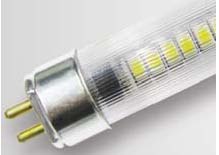The dimming types are explained below:
Phase Dimming
There are two types of Phase Dimming: Leading Edge Dimming and Trailing Edge Dimming
Leading Edge dimming is sometimes called Forward Phase or TRIAC dimming
Trailing Edge dimming is sometimes called Reverse Phase or Electronic Low Voltage Dimming.
Some LED drivers are compatible with both Leading Edge and Trailing Edge Phase Dimmers, This driver with Phase Dimming built in.
There is a massive installed base of phase dimmers which is why they are so popular.
There are no additional wires on a Phase Dimming driver. The dimmer is wired in line with the output of the driver.
Phase dimming is only available in AC 120V/110V 60Hz input or AC 220V/230V 50Hz
0-10V Dimming
This dimming type is used in most new construction and commercial applications.
One kind LED drivers with are compatible with 0-10V dimmers, This driver with 0-10V dimming built in.
There are extra wires (usually grey and purple) on the driver that hook up to the 0-10V dimmer.
9V is the maximum light level and 1V is the minimum light level.
0-10V dimming is available in universal AC110V-277V input.
Control type: 0-10V
0-10v dimmable led lights, 0-10v dimmable downlight, 0 10v dimming led fixtures, 0 10v led dimmer, 0 10v dimming
0-10V is an analog lighting control protocol. Basically, a 0-10V control applies a voltage between 0 and 10 volts DC to produce a varying intensity level. There are actually two existing 0-10V standards. They are not compatible with each other, so it is essential to understand which type is required. The original 0-10V control was used for controlling theatrical lighting. A lighting console provides a separate 0-10V output for each dimming channel that connects to the input to dimmer modules located in a remote panel. The other 0-10V control method was developed for, and is used as, a standard means for controlling fluorescent dimming ballasts. It has now become popular for some drivers used for LED lighting.
0-10V Basics
The two 0-10V control types are current source (a theatrical dimming standard) and current sink (a dimming ballast standard).
There is an IEC standard for current sink controls - Standard 60929 Annex E. The standard requires that the ballast (or driver) provides full light output when the control voltage is 10 Volts (or above). As the control voltage is reduced by the control, the light level is reduced. At a control voltage of 1 volt, the ballast (driver) provides it’s minimum light level. Any voltage less than 1 volt is defined as minimum. Some drivers' minimum is off, while other drivers' minimum is the lowest light level of the driver. It is important to understand what minimum is for a particular driver. For drivers that do not go to off at minimum, a separate relay or switching device is required.
An additional specification that needs to be considered is the current carrying capacity of the control. Standard 60929 Annex E requires the ballast (driver) to limit the current draw to 2.0 mA maximum. This means that a control with a 50mA capacity can operate 25 ballasts (drivers) if they have a specified current of 2.0mA.
Current sourcing controls for 0-10V are supported by the standard ESTA E1.3, Entertainment Technology – Lighting Control System – 0-10V Analog Control Protocol, Draft 9 June 1997. It defines 10V as 100% light level and 0V as off. Drivers using this protocol require the control to provide (source) the voltage.
0-10V Applications
Basic Applications
1. One or more LED zones of a single color that require the intensity level to be adjusted to one or more preset levels.
2. Simple three color Red, Green, Blue (RGB) or four color Red, Green, Blue, White (RGBW) where one zone is assigned to each color. The controller adjusts the intensity of each of these colors so that any possible color can be produced. This color mixing is either static or sequences in 10-20 steps.
3. These applications can be for indoor or outdoor lighting and exist in retail spaces, high-end residences, and many commercial spaces.
Complex Applications
1. A large number of LED zones are required for advanced lighting effects with color changing LEDs. There are multiple groups of RGB or RGBW LEDs and they require multiple cues and sequences. Nova, Nova T*, and Diva 0-10V controls with PP-120H relay module
2. These applications are mainly seen on building facades, retail, and entertainment spaces and in theatrical applications, but can be used in any space that calls for advanced color mixing effects.Grafik Eye 3000/4000 systems with either GRX-TVI interfaces or LP/GP panels containing TVM modules
3. Although 0-10V drivers and controls can be used, it is advisable to use DMX512 protocol products for complex applications.Grafik Eye QS products with GRX-TVI interface.
0-10V dimmer compatible with LED bulb problem. If the lamp fixture has Dylanite 0-10V dimmer wall switch or Lutron 0-10V dimmer wall switch And other Brand 0-10V dimmer wall switch, Be noted that the electronic transformer driver/Ballasts has two kinds:
A. New design transformer driver/Ballasts: The output of your 0-10V DC PWM dimming, This is compatible with our 12V led bulb or 24V LED bulb and other constant voltage led bulb.
B. Old design electronic transformer driver/Ballasts: This is AC output, For increase efficacy while limiting EMI, This electronic ballasts typically operate at a frequency between 20 and 60 kHz., Nothing led bulb is dimmable for this electronic transformer driver/Ballasts, for example ELB Electronics 0-10V T8 Ballasts, Metrolight Smart Electronic Ballasts for HID.


